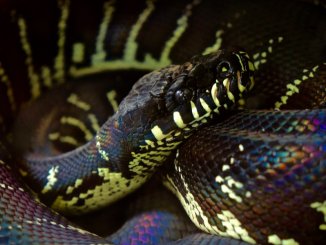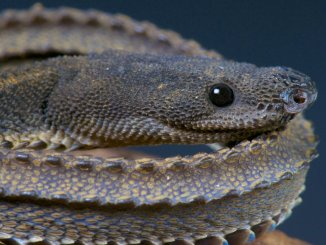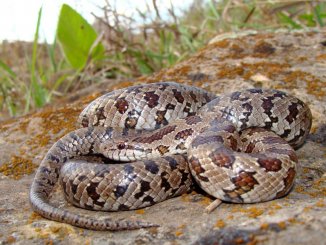The tricolor hognose is a small colubrid snake originating in Argentina, Brazil, Paraguay, and Bolivia. Tricolor hognoses are easy to care for as long as they’re housed in a clean, sanitary environment.
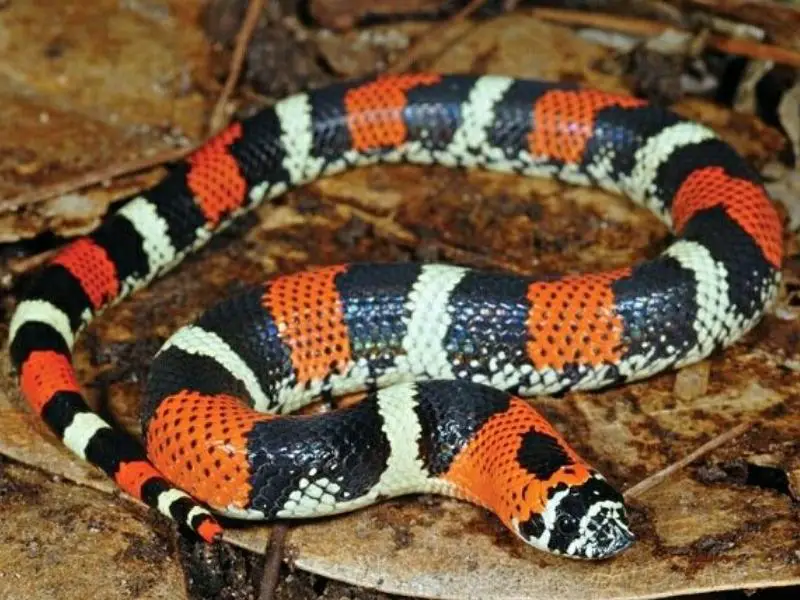
Tricolor Hognose Overview
| Common name | Tricolor hognose |
| Scientific name | Xenodon pulcher |
| Natural habitat | Dry, sandy grasslands, shrublands, and savannahs in Argentina, Brazil, Paraguay, and Bolivia |
| Adult size | 18–24 inches |
| Average lifespan | 7–8 years |
| Diet | Carnivore |
| Housing | Minimum 10 gallons, 70–90°F, 60–65% humidity |
| Experience level | Beginner–moderate |
Origin
The tricolor hognose (Xenodon pulcher) originates in dry, sandy environments in South American regions. The snake is frequently found in grasslands, shrublands, and savannahs, near lakes or streams.
The snake is well-adapted to living in its wild habitat and has an upturned snout that aids in digging in sandy soil and burrowing in masses of humus.
Appearance and Behavior
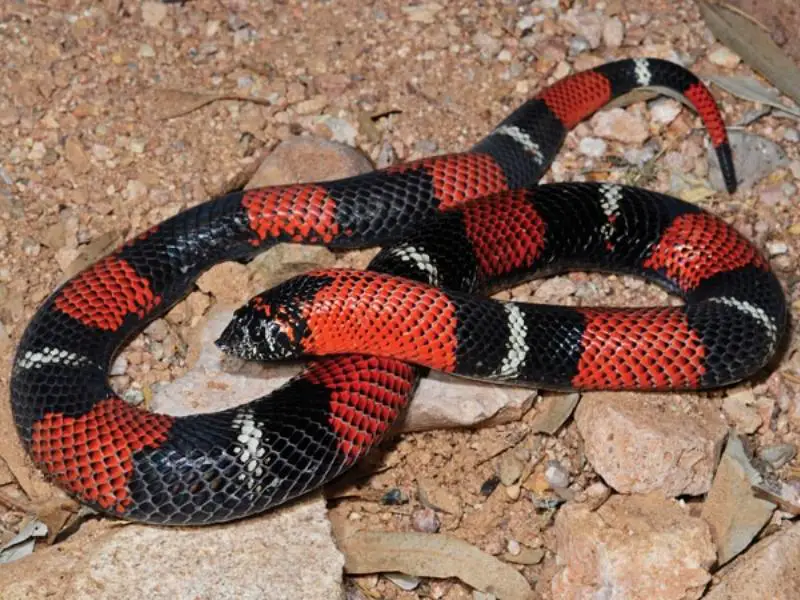
The tricolor hognose is a small, colorful snake that has a black or white head and black, red, and yellow or white bands encircling its body from head to tail.
This species has the same colors and markings as the coral snake group and is often referred to as the false coral snake.
The rostral scale, or the plate on the tip of the snout, is the tricolor hognose’s standout feature. This scale is upturned in a hog-like manner, giving the snake the name hognose.
Tricolor hognoses are often confused with western hognoses, but tricolor hognoses are smaller and slimmer than western hognoses.
Females are larger and have shorter, stubbier tails than males.
Size and Lifespan
The average length of a female tricolor hognose is 24 inches, while males usually grow 18–20 inches. Tricolor hognoses have short lives. Both males and females live up to 8 years on average.
Temperament
The tricolor hognose is a gentle, timid snake that is more likely to hide from potential predators than attack. The snake isn’t usually aggressive, but it may become defensive and bite when handled until it realizes you’re not a threat.
If handled frequently, the snake becomes more friendly and docile over time.
Tricolor hognoses are solitary creatures that prefer to be housed alone. The snakes become stressed if their environment isn’t suitable for their needs, or if they feel threatened.
Refusing to eat, rubbing against objects, and hissing or striking are all signs of stress.
Housing Tricolor Hognoses
The tricolor hognose’s natural habitat is dry, sandy regions in tropical and subtropical climates. To ensure the snake is comfortable in captivity, provide a similarly dry, humid, sandy environment in the enclosure.
The best type of enclosure for a tricolor hognose is a wooden vivarium, with adjustable vents to achieve optimal moisture levels.
Enclosure size
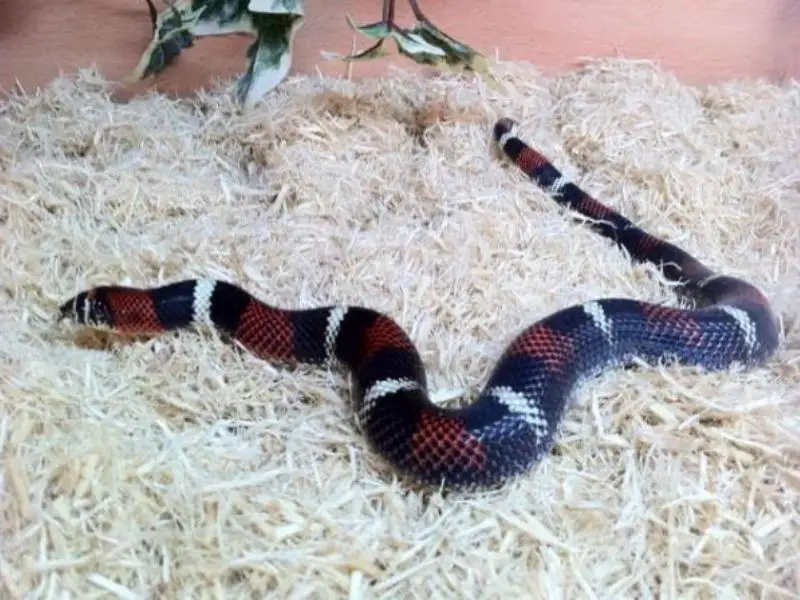
A single adult tricolor hognose needs an enclosure size of at least 10 gallons, but preferably 20 gallons. The snake is a burrowing, terrestrial species, and needs more horizontal space than vertical space in the tank.
The ideal measurements for an adult snake’s enclosure are 24–36 inches long by 12–18 inches deep by 8–12 inches tall.
Lighting
Tricolor hognoses don’t need UVB sunlight to convert inactive vitamin D to active vitamin D3. However, UVB can still be used to simulate natural sunlight in captivity.
Mount a 2–5% UVB tube to the underside of the roof at the back of the enclosure, ensuring that the snake can’t come within 12 inches of the bulb.
Keep the UVB lighting on for a 12-hour cycle, and turn it off overnight, to mimic a day-to-night cycle.
Make sure there are hiding spots around the enclosure that the snake can use when it wants a break from UVB during the day.
Alongside UVB lighting, provide natural, ambient lighting in the room the enclosure is kept in.
Temperature and Humidity
In the wild, the tricolor hognose is adapted to temperatures of up to 90°F in the sun. Maintain this temperature in about one-third of the enclosure, and maintain a temperature of around 70°F in the rest of the tank, to allow the snake to regulate its temperature by moving around.
To achieve this temperature gradient, install a basking lamp on the ceiling in the warm end of the enclosure. Place a guard around the basking lamp to prevent injuries to the snake, and keep the lamp on for 12 hours per day. To keep the basking area warm overnight, use a heat mat set to 80°F.
Monitor the temperature of the hot and cool ends of the enclosure with a thermostat.
Tricolor hognoses prefer a humid environment. Place a large, shallow water bowl in the enclosure and spray the substrate once or twice a day with room-temperature water to maintain a humidity of 60–65%.
Use a hygrometer to ensure humidity is consistent throughout the day.
To help the snake to shed comfortably, make a humidity hide — a high-humidity hole that replicates the humid hiding holes in the wild — out of a small plastic tub filled with moisture-holding sphagnum moss, with a hole for the snake to enter.
Substrate and Decoration
Line the enclosure with an easy-to-clean, dust-free substrate that won’t increase humidity levels. Coarse beech woodchip is a good, clean, affordable choice. A soil-clay mix with sand for aeration can be used to create a more natural look.
Place large, flat rocks and slate in the basking area to provide warm spots for the snake to rest. Artificial ornaments, like caves and castles, can be used to make the tank look attractive and provide hiding and sleeping spots for the snake.
Ensure the ornaments are heavy and can’t be moved by the snake.
Ferns and ficus plants are good foliage options for the tank, but if you prefer to keep a low-maintenance enclosure, plants aren’t necessary.
Cleaning
Tricolor hognose snakes thrive in a clean environment. Spot-clean the tank once a day, remove and replace soiled parts of the substrate, and do a full, deep clean once every four weeks.
To deep clean, first, relocate the snake to a separate enclosure. Remove everything from the home enclosure. Use a reptile-friendly disinfectant or warm, soapy water to wipe down the enclosure base and walls, then wipe the enclosure dry with a clean paper towel.
Add a fresh layer of the substrate to the enclosure floor. Rinse the decorations in warm water, then dry them off and return them to the tank.
Don’t use bleach or other chemical cleaning products that could cause respiratory distress in the snake.
Tricolor Hognose Care
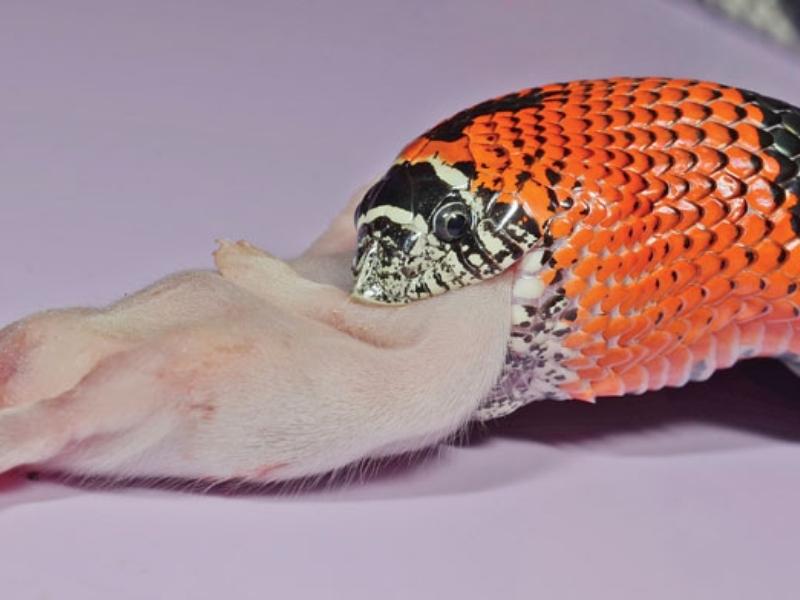
Tricolor hognoses need a clean tank, a constant supply of freshwater, and routine feeding. Caring for these shakes is easy.
Food and Water
Provide tricolor hognoses with a staple diet of mice. Young snakes should be fed one defrosted pinky mouse every four to five days. When the snakes reach six months old, feed them one large mouse every one to two weeks.
To prevent obesity, don’t feed your snake any more frequently than this.
If your snake won’t take mice, try alternative foods, like gerbils, multimammate mice, or chicks. Tricolor hognoses have a strong feeding response, so use tongs to safely feed the snakes.
Place a medium or large, shallow water bowl on the cool side of the enclosure to provide a constant source of clean water. Empty and refill the bowl with clean water once a day.
Handling
Tricolor hognoses are calm snakes that respond well to gentle handling. Handle your snake for up to five minutes, two or three times per week.
At first, the hognose may perceive you as a threat and become stressed and try to bite or escape. If this happens, put the snake back in the enclosure and try again another day. Eventually, the snake will become used to your touch.
Over-handling and improper handling, including squeezing the snake, handling the snake before it sheds or after it has eaten, and restraining the snake in any way, cause the snake to become stressed.
Make sure children know how to correctly handle a snake before they’re allowed to do so.
Common Health Issues
Tricolor hognoses are healthy, hardy snakes, but poor care can lead to parasitic diseases and blister disease.
Parasitic Diseases
Parasitic diseases, including internal parasites (such as worms and coccidia) and external parasites (like mites and ticks), are caused by poor hygiene, which results in contaminated environments.
Breathing difficulties, regurgitation, diarrhea, itching, anemia, and mouth infections are all signs of parasitic diseases. To treat parasites, ask your vet for antiparasitic medications and deep clean the entire tank to eliminate an infestation.
Blister Disease
Blister disease, or vesicular dermatitis, is a skin infection that causes lesioning and blistering. This infection occurs when the substrate is too damp or the humidity levels in the enclosure are too high.
If left untreated, the disease can be fatal. Treat blister disease with antibiotics recommended by your veterinarian, and ensure the substrate isn’t too damp.
Breeding
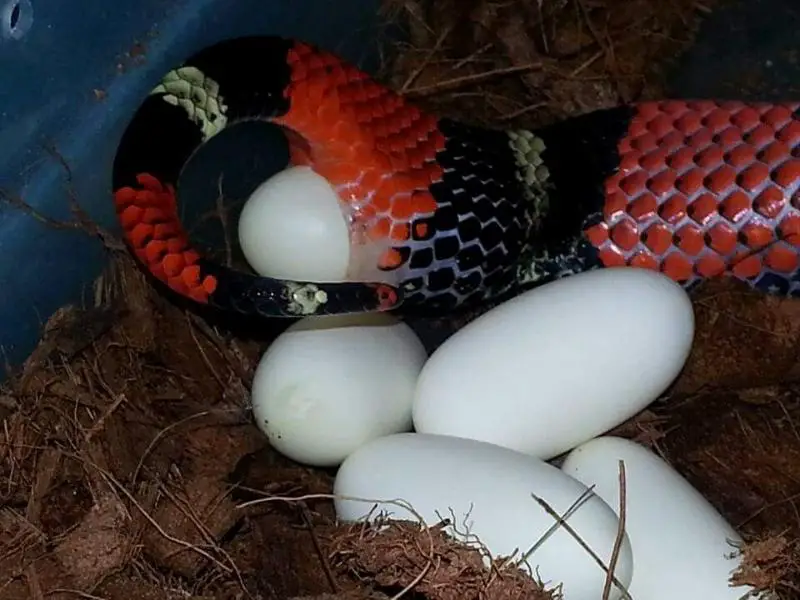
Tricolor hognoses are easy to breed in captivity. The snakes reach sexual maturity at 18–24 months old.
To breed a male and female tricolor hognose, follow these steps:
- Set up a 20–30-gallon enclosure for breeding. Decorate the enclosure to match the snakes’ home enclosures, use a paper towel as a substrate to maintain high humidity levels, and add a nesting box containing a humid soil mix for the female to lay her eggs. The box should be big enough for the female to fully turn around in
- Place an adult male and female snake in the enclosure. If the snakes are healthy and sexually mature, they should breed without intervention and will stay joined for several hours as the male fertilizes the female’s eggs
- The female will lay her eggs in the nesting box. The eggs should be incubated in an incubator box at a temperature of 84°F
- The eggs will hatch after about 60 days. The hatchlings are independent of birth, so the parents can be returned to their home tanks immediately
- Remove the hatchlings from the incubator box and keep them in the breeding tank until their first shed, after about one week
- After the first shed, move the hatchlings to separate enclosures and feed them thawed pinkie mice every five days
Choosing and Buying a Tricolor Hognose
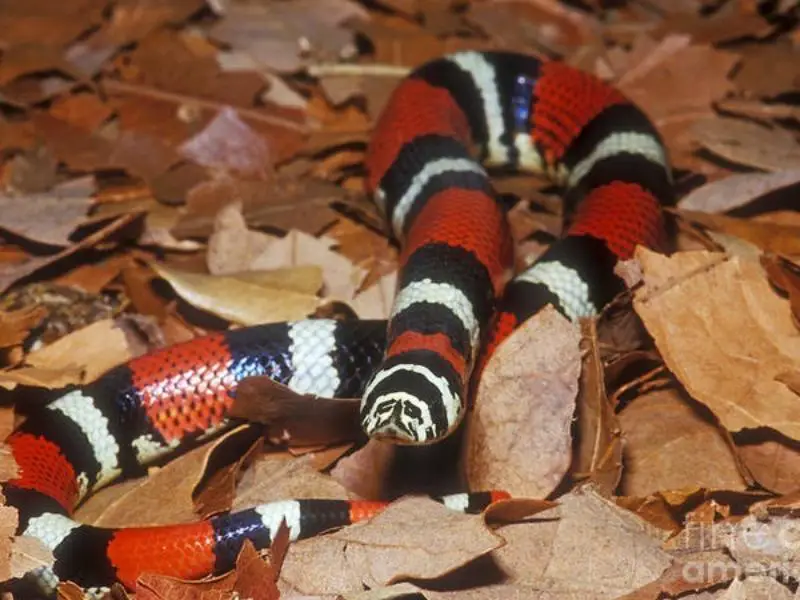
The average cost of a tricolor hognose is $200 to $450. Snakes aren’t common in captivity.
Tricolor hognoses are sold at some retail pet stores and by reptile breeders. When buying from a breeder, ask questions to ensure the snakes are being bred ethically, and ask to see the snake in person before making a purchase.
Look for signs of good health in the snake, including smooth, shiny scales, clear, alert eyes, and normal feeding habits. Don’t buy a snake that has lesions, sores, redness, labored breathing, cloudy eyes, or any other signs of illness.

